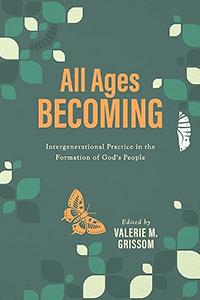What does intergenerational preaching look like? David Csinos shares that it is an emergent, experimental, and highly contextual endeavor that disrupts traditional homiletical norms. He offers three guiding principles to help cultivate the practice of intergenerational preaching: simplify the language, encourage conversation, and share the pulpit.
Intergenerational preaching is not for the faint of heart. It is an emergent, experimental, and highly contextual endeavor that upsets the homiletical status quo by taking into consideration groups of people who are often kept on the sidelines by more common forms of preaching. While I cannot tell you exactly what preaching with all ages looks like in your faith community, or how you should go about trying it for yourself, there are some concrete principles that can guide those who want to cultivate practices of intergenerational preaching in their faith communities.
Simplify the language, not the concept.
First, when teaching and preaching among intergenerational contexts, we should consider the language we are using. If we want everyone present to understand what we are saying, then we need to use simple language. However, as Sandy Sasso has pointed out, simple language can be used to convey complex and profound concepts (Sandy Eisenberg Sasso, CopperHouse, 2015). Talashia Keim Yoder is an intergenerational preacher who knows how important this principle can be: “We do not ‘water down’ theology or Scripture. On the contrary, we do the difficult work of ‘distilling’ it and boiling it down to its essence, all the while using language that is accessible to everyone” (Cisnos, A Gospel for All Ages, 99). Jesus knew the power of using simple language that was understandable and relevant to the context in which he ministered. He spoke of sheep (Luke 15:1-17) and lilies (Luke 12:27) and foxes (Matt. 8:20) and seeds (Mark 4:1-20).
1. Intergenerational language. As you prepare your next message, think about the language you are using to convey your ideas. Does it require knowledge that not all ages in the congregation might have? If so, how might you swap out some words for others that are more commonly understood?
2. Intergenerational explanation. Do you take the time to explain more complex language, even words that might seem commonplace in church? If not, then add a sentence or two that unpacks what you mean when you say words like hermeneutic, salvation, justification, redemption, and so on.
3. Intergenerational imagery. Are the analogies, metaphors, and similes you include relevant for all ages? If not, change them; instead of talking about the importance of a cornerstone through architecture and design, try explaining it through Lego (you may even build something out of Lego as you speak).
It helps no one if the powerful ideas you wish to convey in your message are not understandable to everyone simply because of how you say them. So, whatever you do, ensure that you preach with language that makes sense to all ages. If the children in your church can comprehend your message, chances are everyone else can too.
Encourage conversation.
Intergenerational preachers know the power of questions and conversation for helping people grow and learn. Messages that are monologues proclaimed from the pulpit by one person have a place in the preaching practices of congregations, but their effectiveness can be enhanced when blended with approaches for helping people discuss and wonder about Scripture for themselves. Preachers can invite conversation in many ways.
1. Intergenerational conversation. Consider offering a short sermon and then allowing the preaching moment to continue by asking a question and inviting everyone to turn to a few people around them and respond to it in conversation with one another.
2. Reflection time. At one church I attended, we included a time after the message where everyone in this small, intergenerational community could ask the minister questions or share their reflections on the message they had just heard.
These seem like simple ideas. And in a way, they are no-brainers. And yet messages that are monologues remain the order of the day. As you experiment with intergenerational preaching, consider how you might ask questions and invite discussion as part of your message so everyone present, from a young child to a senior citizen, might dig into Scripture and preach the gospel to one another.
Share the pulpit.
When Jesus lifted up and blessed that child—a child too young to be able to approach Jesus on their own—he was moving over and sharing space with that infant. No longer was Jesus preaching and teaching the crowds by himself. Now that child was preaching alongside Jesus, not with words, but by his presence alone. Preaching among all-age communities can mean we share the pulpit with people of diverse ages. If the common identity we hold as followers of Jesus surpasses the identity we hold by virtue of our age, education, or ordination status, then we can rest assured, knowing that we all have something to teach one another about the gospel. Intergenerational preachers can make space for other people to preach to the faith community, regardless of age.
1. Events with many preachers. One way to share the pulpit is to ask children, adolescents, and adults of varying ages to prepare a short reflection on a text, on a celebration or feast in the church calendar (like Easter, Christmas, or All Souls’ Day), or on a common theme. Instead of having one person preach, the “sermon” could be made up of four or five mini-messages offered by this diverse group of congregants.
2. Intergenerational testimonies. Another idea is to ask people of different ages to tell stories of how God has been working in their lives lately and then listen to what these experiences might teach us about who God is and how God works in our everyday lives. Some preachers have shared the pulpit by interviewing family about a monumental moment in their common faith life, such as when they welcomed a new family member, lost a loved one to an illness, or celebrated the union of two people in marriage. Instead of announcing these events in a bulletin or even mentioning them in a sermon, preachers can (with the family’s permission, of course) invite the family to talk about their experience and God’s presence therein in front of the whole congregation.
As you can see, when we expand our culturally conditioned views about what counts as preaching, we can make room for all sorts of people to preach in all sorts of ways.
 This article is an excerpt from All Ages Becoming: Intergenerational Perspectives in the Formation of God’s People (Abilene Christian University Press, 2023) edited by Valerie M. Grissom. This book is available available at ACU Press Books, Cokesbury, and Amazon.
This article is an excerpt from All Ages Becoming: Intergenerational Perspectives in the Formation of God’s People (Abilene Christian University Press, 2023) edited by Valerie M. Grissom. This book is available available at ACU Press Books, Cokesbury, and Amazon.
Related Resources
- Being the Body of Christ through Intergenerational Christian Practice featuring Valerie Grissom — Watch the Leading Ideas Talks podcast video | Listen to the podcast audio version | Read the in-depth interview
- Why Intergenerational Ministry? By Liz Perraud
- 6 Suggestions to Promote Healthy Intergenerational Worship by David W. Manner
- 5 Benefits of Intergenerational Christian Formation by Holly Allen, Christine Lawton, and Cory L. Seibel
- 10 Things Great Preachers Do by Charley Reeb







